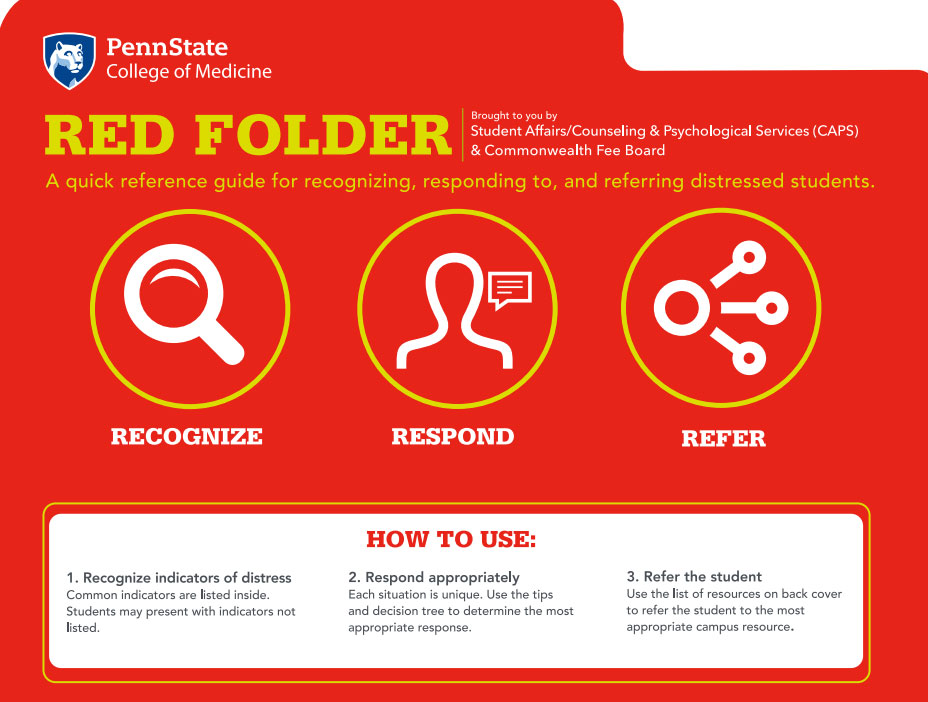 The “Red Folder” guide was produced by Penn State’s Student Affairs/Counseling and Psychological Services and Commonwealth Fee Board, and updated with Hershey-specific information by the Office for Professional Mental Health at Penn State College of Medicine.
The “Red Folder” guide was produced by Penn State’s Student Affairs/Counseling and Psychological Services and Commonwealth Fee Board, and updated with Hershey-specific information by the Office for Professional Mental Health at Penn State College of Medicine.
The folder is a quick-reference guide to help faculty and staff recognize, respond to and refer distressed students. You can also download this resource as a PDF from OneDrive to print it out (updated June 21, 2019).
How to Use the Guide
Recognize indicators of distress
- Common indicators are listed below. Students may present with indicators not listed.
Respond appropriately
- Each situation is unique. Use the tips and decision tree to determine the most appropriate response
Refer the student
- Use the list of resources to refer the student to the most appropriate campus resource.
Jump to topic
Search
Recognize
Look for groupings, frequency, and severity of behaviors, not just isolated symptoms.
- Sudden decline in quality of work and grades
- Frequently missed classes and assignments
- Disturbing content in writing or presentations
- Classroom disruptions
- Consistently seeking personal rather than professional advice
- Multiple requests for extensions/special considerations (a change from prior functioning)
- Doesn’t respond to repeated requests for contact/meetings
- Marked changes in physical appearance (e.g., poor grooming/hygiene or sudden weight loss/gain)
- Strange or bizarre behavior indicating loss of contact with reality
- Visibly intoxicated or smelling of alcohol or marijuana
- Rapid speech or manic behavior
- Depressed or lethargic mood or functioning
- Observable signs of injury (e.g., facial bruising or cuts)
- Self-disclosure of personal distress (e.g., family problems, financial difficulties, assault, discrimination, legal difficulties)
- Unusual/disproportionate emotional response to events
- Excessive tearfulness, panic reactions
- Verbal abuse (e.g., taunting, badgering, intimidation)
- Expressions of concern about the student by peers
- Verbal, written, or implied references to suicide, homicide, assault or self-injurious behaviors
- Unprovoked anger or hostility/physical violence (e.g., shoving, grabbing, assaulting, use of weapon)
- Academic assignments dominated by themes of extreme hopelessness, helplessness, isolation, rage, despair, violence, self-injury
- Stalking or harassing
- Communicating threats/disturbing comments via email, correspondence, texting or phone call
Respond
Use these tips to determine the most appropriate response for a distressed student.
Mandatory reporting
In addition to referring a student to resources, any sexual or gender-based harassment or assault requires mandated reporting. For questions regarding mandated reporting, please contact the Office of Sexual Misconduct Prevention and Response at 814-867-0099.
Call Penn State Police or 911 if there is an imminent danger to the student, you, or anyone else
Take a few deep breaths to calm yourself. Use a calm voice when talking and asking questions.
If this is not an imminently dangerous situation, take time to think through what might be the most helpful step.
You are not alone. Ask those around you for help. Consult with a colleague, call another office on campus (see resources)
Make eye contact, give your full attention. Restate what the student says to make sure you understand what is causing the distress and/or what they are asking for help with.
Don’t be afraid to directly ask the student if they are having thoughts of harming themselves or others (by asking, you are not instilling the thought).
Help get them to the next step (e.g., contact the academic advisor with the student to make an appointment; help them call counseling services to schedule an appointment).
Refer
Follow the steps below to determine who to contact when you are concerned about a student who is distressed and/or disruptive. Emergency and campus resources are listed.
Call 911 or Penn State Police at 717-531-8888.
Refer the student to campus resources as appropriate.
Call the Office for Professional Mental Health or the Penn State Crisis Line at 877-229-6400. Then, refer the student to appropriate campus resources.
Report to Campus Safety and Security 717-531-8711 or the Behavioral Threat Management Team.
Resources
- Campus Safety and Security, 717-531-8888 or 911
- Penn State Crisis Line, 1-877-229-6400
- 24/7 confidential service
- Licensed mental health counselors
- YMCA/Rape Crisis and Domestic Violence Services, 1-800-654-1211
- Off-campus services for victims of sexual and relationship violence and stalking
- 1101 Market St., Harrisburg, PA 17103
- Behavioral Threat Management Team, 814-863-2868
- Report concerns about any person, including threatening or disruptive behavior
- Referrals to support services
- https://btmt.psu.edu
- Office of Professional Mental Health, 717-531-8658
- Crisis, consultation and counseling services
- PMH@pennstatehealth.psu.edu
- Student Conduct, 717-531-5665
- Report possible violations of the Code of Conduct (excludes sexual misconduct — see PMH office for details)
- Student Affairs, C1802
- Financial Advising, 717-531-7052
- C1805
500 University Dr.
Hershey, PA 17033
- C1805
- Academic advising, 215-881-7328
- Medical students, C1802, 717-531-4398
- Physician assistant students, CG638B, 717-531-0003, ext. 285595
- Graduate students, C1602, 717-531-8892
- International student advising, 717-531-4101
- Support for international students, including advice on visas and immigration issues
- C1802
500 University Dr.
Hershey, PA 17033
- Student health, 717-531-5998
- C1802
845 Fishburn Road
Hershey, PA 17033
- C1802
- Diversity/multicultural resources, 717-531-1012
- Provides support, advocacy and education for underrepresented populations
- diversity@pennstatehealth.psu.edu
- Penn State Office of Sexual Misconduct Prevention and Response, 814-867-0099
- Report sexual or gender-based harassment or misconduct (e.g., sexual assault, exploitation, stalking, dating/domestic violence)
- Investigates concerns; provides resources, support and accommodations to students with disabilities
